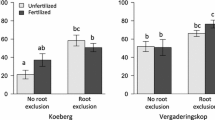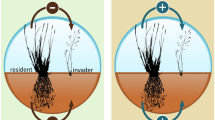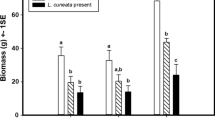Abstract
Effects of invasive plant species on native plant species are frequently assumed or inferred from comparisons, but rarely quantified experimentally. Such quantification is important to assessing risks and impacts of invasives. We quantified the effects of Lonicera maackii, an exotic shrub invasive in many eastern North American forests, on survival, growth, and reproduction of three perennial herbs: Allium burdickii, Thalictrum thalictroides , and Viola pubescens. We predicted that the spring ephemeral, A. burdickii , would be most impacted, due to early leaf expansion of L. maackii. Field experiments were carried out in two deciduous forest stands, one (Gregg’s Woodlot, GW) disturbed and the other (Western Woods, WW) relatively undisturbed. In each stand, individual herbs were transplanted into a blocked design of 60 plots where L. maackii was present, absent, or removed, and monitored for 5 growing seasons. Lonicera maackii did not affect survival of transplants, but reduced growth and final size of individuals of all three species. For two of the species, A. burdickii and V. pubescens, L. maackii reduced the proportion of live plants flowering in both stands, and reduced the seed or fruit number per flowering individual in GW. For T. thalictroides the proportion flowering was not affected, but seed number per flowering plant was reduced by L. maackii in both stands. For all three species, cumulative seed production over the course of the study was reduced by L. maackii. Overall, effects on the spring ephemeral, A. burdickii, were similar to effects on the other herbs. Because mortality of these established individuals was not affected, short-term studies might conclude forest herbs are unaffected by invasive shrubs. However, the growth and reproduction impacts documented here suggest that populations are impacted in the long-term.






Similar content being viewed by others
References
Allison PD (1995) Survival analysis using the SAS system: a practical guide. SAS Institute, Cary, N.C.
Ballard HE (1994) Violets of Michigan. Mich Bot 33:131–199
Berg H, Redbo-Torstensson P (1998) Cleistogamy as a bet-hedging strategy in Oxalis acetosella, a perennial herb. J Ecol 86:491–500
Berg H, Redbo-Torstensson P (1999) Offspring performance in three cleistogamous Viola species. Plant Ecol 86:49–58
Böhning D, Dietz E, Schlattmann P (1997) Zero-inflated count models and their applications in public health and social science. In: Rost J, Langeheine R (eds) Applications of latent trait and latent class models in the social sciences. Waxmann, Münster, pp 333–344
Byers JE (2002) Impact of non-indigenous species on natives enhanced by anthropogenic alteration of selection regimes. Oikos 97:449–458
Collier MH, Vankat JL, Hughes MR (2002) Diminished plant richness and abundance below Lonicera maackii, an invasive shrub. Am Midl Nat 147:60–71
Cronk QCB, Fuller JL (1995) Plant invaders. Chapman and Hall, London
Culver DC, Beattie AJ (1978) Myrmecochory in Viola: dynamics of seed-ant interactions in some West Virginia species. J Ecol 66:53–72
D’Antonio CM, Kark S (2002) Impacts and extent of biotic invasions in terrestrial ecosystems. Trends Ecol Evol 17:202–204
Davis MA (2003) Biotic globalization: does competition from introduced species threaten biodiversity? BioScience 53:481–489
Davis MA, Grime JP, Thompson K (2000) Fluctuating resources in plant communities: a general theory of invasibility. J Ecol 88:528–534
Dillenburg LR, Whigham DF, Teramura AH, Forseth IN (1993) Effects of below-and above-ground competition from the vines Lonicera japonica and Parthenocissus quinquefolia on the growth of the tree host Liquidambar styraciflua. Oecol 93:48–54
Evans LT (1956) Chasmogamic flowering in Viola palustris L. Nature 178:1301
Foré SA, Vankat JL, Schaefer RL (1997) Temporal variation in the woody understory of an old-growth Fagus-Acer forest and implications for overstory recruitment. J Veg Sci 8:607–614
Fox GA (1993) Failure-time analysis: emergence, flowering, survivorship, and other waiting times. In: Scheiner SM, Gurevitch J (eds) Design and analysis of ecological experiments. Chapman and Hall, New York, pp 253–289
Gleason HA, Cronquist AC (1991) Manual of vascular plants of northeastern United States and adjacent Canada, 2nd edn. The New York Botanical Garden, New York
Gorchov DL, Trisel DE (2003) Competitive effects of the invasive shrub, Lonicera maackii (Rupr.) Herder (Caprifoliaceae), on the growth and survival of native tree seedlings. Plant Ecol 166:13–24
Gould AMA, Gorchov DL (2000) Effects of the exotic invasive shrub Lonicera maackii, Amur Honeysuckle, on survival and fecundity of native forest annual herbs. Am Midl Nat 144:36–50
Guisan A, Theurillat JP (2000) Equilibrium modeling of alpine plant distribution: how far can we go? Phytocoenologia 30:353–384
Hubbell SP (2001) The unified neutral theory of biodiversity and biogeography. Princeton University Press, New Jersey
Huenneke LF, Thomson JK (1995) Potential interference between a threatened endemic thistle and an invasive nonnative plant. Conserv Biol 9:416–425
Hutchinson TF, Vankat JL (1997) Invasibility and effects of Amur Honeysuckle in southwestern Ohio forests. Conserv Biol 11:1117–1124
Jones AG (1979) A study of wild leek, and the recognition of Allium burdickii (Liliaceae). Syst Bot 4:29–43
Lubbers AE, Christensen NL (1986) Intraseasonal variation in seed production among flowers and plants of Thalictrum thalictroides (Ranunculaceae). Am J Bot 73:190–203
Luken JO (1988) Population structure and biomass allocation of the naturalized shrub Lonicera maackii (Rupr.) Maxim. in forest and open habitats. Am Midl Nat 119:258–267
Luken JO, Thieret JW (1995) Amur Honeysuckle (Lonicera maackii; Caprifoliaceae): its ascent, decline, and fall. Sida 16:479–503
Luken JO, Tholemeier TC, Kunkel BA, Kuddes LM (1995) Branch architecture plasticity of Amur Honeysuckle (Lonicera maackii (Rupr.) Herder): Initial response in extreme light environments. Bull Torrey Bot Club 122:190–195
Luken JO, Kuddes LM, Tholemeier TC, Haller DM (1997) Comparative responses of Lonicera maackii (Amur Honeysuckle) and Lindera benzoin (Spicebush) to increased light. Am Midl Nat 138:331–343
Mack RN, Simberloff D, Lonsdale WM, Evans H, Clout M, Bazzaz FA (2000) Biotic invasions: causes, epidemiology, global consequences, and control. Ecol Appl 10:689–710
Matilla T, Salonen V (1995) Reproduction of Viola mirabilis in relation to light and nutrient availability. Can J Bot 73:1917–1923
Mayers AM, Lord EM (1983) Comparative flower development in the cleistogamous species Viola odorata I.: a growth rate study. Am J Bot 70:1548–1555
McCarthy BC (1997) Response of a forest understory community to experimental removal of an invasive nonindigenous plant (Alliaria petiolata, Brassicaceae). In: Luken JO, Thieret JW (eds) Assessment and management of plant invasions. Springer, Berlin Heidelberg New York, pp 117–130
McKenzie D, Halpern CB (1999) Modeling the distributions of shrub species in Pacific northwest forests. For Ecol Manage 114:293–307
McNeal DW, Jacobsen TD (2002) Allium. In: Flora of North America Editorial Committee (eds) Flora of North America north of Mexico, Magnoliophyta: Lilidae: Liliales and Orchidales, vol 26. Oxford University Press, New York, pp 224–276
Medley KE (1997) Distribution of the non-native shrub Lonicera maackii in Kramer Woods, Ohio. Phys Geogr 18:18–36
Meekins FF, McCarthy BC (1999) Competitive ability of Alliaria petiolata (Garlic Mustard, Brassicaceae), an invasive, nonindigenous forest herb. Int J Plant Sci 160:743–752
Midgley GF, Rutherford MC, Davis GW, Bosenberg JD (1992) Photosynthetic response of heliophilous Rhus species to environmental modification by invasive shrubs. Funct Ecol 6:334–345
Miller KE (1991) Effects of the invasive shrub, Lonicera maackii (Amur honeysuckle), on survival, growth, and fecundity of native understory perennial herbs in southwestern Ohio forests. MS thesis, Miami University, Oxford, Ohio
Mitchell RJ (1993) Path analysis: pollination. In: Scheiner SM, Gurevitch J (eds) Design and analysis of ecological experiments. Chapman and Hall, New York, pp 211–231
Nagelkerke NJD (1991) A note on the general definition of determination. Biometrika 78:691–692
Nault A, Gagnon D (1993) Ramet demography of Allium tricoccum, a spring ephemeral, perennial forest herb. J Ecol 81:101–119
Parker IM, Simberloff D, Lonsdale WM, Goodell K, Wongam M, Kareiva PM, Williamson MH, Von Holle B, Moyle PB, Byers JE, Goldwasser L (1999) Impact: toward a framework for understanding the ecological effects of invaders. Biol Invasions1:3–19
Pimentel D, Lach L, Zuniga R, Morrison D (2000) Environmental and economic costs of nonindigenous species in the United States. Bioscience 50:53–65
Ridout MS, Demetrio CGB, Hinde JP (1998) Models for count data with many zeros. In: Proceedings of the XIXth International Biometrics Conference. Cape Town, South Africa, pp 179–192
Rothstein DE, Zak DR (2001) Photosynthetic adaptation and acclimation to exploit seasonal periods of direct irradiance in three temperate, deciduous-forest herbs. Funct Ecol 15:722–731
SAS (1989) SAS/STAT user’s guide, version 6, 4th edn, vol 2. SAS Institute, Cary, N.C.
Schemske DW (1978) Evolution of reproductive characteristics in Impatiens (Balsaminaceae): the significance of cleistogamy and chasmogamy. Ecology 59:596–613
Silvertown J, Franco M, Pisanty I, Mendoza A (1993) Comparative plant demography—relative importance of life-cycle components to the finite rate of increase in woody and herbaceous perennials. J Ecol 81:465–476
Solbrig OT, Newell SJ, Kincaid DT (1980) The population biology of the genus Viola: the demography of Viola sororia. J Ecol 68:521–546
Trisel DE (1997) The invasive shrub, Lonicera maackii (Rupr.) Herder (Caprifoliaceae): factors contributing to its success and its effect on native species. Ph.D. Dissertation, Miami University, Oxford, Ohio
Trisel DE, Gorchov DL (1994) Regional distribution, ecological impact, and leaf phenology of the invasive shrub Lonicera maackii. Bull Ecol Soc Am 75(Supplement):231
USDA, NRCS (2001) The Plants Database, Version 3.1 (http://plants.usda.gov). National Plant Data Center, Baton Rouge
Vitousek PM, D’Antonio CM, Loope LL, Westbrooks R (1996) Biological invasions as global environmental change. Am Sci 84:468–478
Waller DM (1979) The relative costs of self- and cross-fertilized seeds in Impatiens capensis (Balsaminaceae). Am J Bot 66:313–320
Witkowski ETF (1991) Growth and competition between seedlings of Protea repens (L.) L. and the alien invasive, Acacia saligna (Labill) Wendl. in relation to nutrient availability. Funct Ecol 5:101–110
Acknowledgements
This research was supported by State of Ohio Academic Challenge Grants administered by the Miami University Department of Botany, the Miami University Summer Scholars Program, and by W.J. and J.W. Hagedorn. We thank the Miami University Natural Areas Committee and Thomas Gregg for access to field sites. We are very grateful to Andrew Gould for establishing plots and constructing exclosures, to Karen Doersam, Katie Dowell, Joe Liszewski, and Andrew Ertley for the season of field work each contributed, and to K. Summerville, M. Edelen, H. Richards, S. Beiting, E. Notman, and R. Hrenko for additional field work. Mike Hughes provided substantial guidance on statistical analyses and wrote the SAS code for the ZIP analyses; John Bailer, Anne Bartuszevige, and Bryan Endress also provided input on statistical analyses. Major portions of this work were completed as part of Kara Miller’s master’s degree at Miami University. We thank A. Bartuszevige, B. Endress, M. Vincent, N. Smith-Huerta, and two anonymous reviewers for helpful comments on earlier drafts.
Author information
Authors and Affiliations
Corresponding author
Rights and permissions
About this article
Cite this article
Miller, K.E., Gorchov, D.L. The invasive shrub, Lonicera maackii , reduces growth and fecundity of perennial forest herbs. Oecologia 139, 359–375 (2004). https://doi.org/10.1007/s00442-004-1518-2
Received:
Accepted:
Published:
Issue Date:
DOI: https://doi.org/10.1007/s00442-004-1518-2




